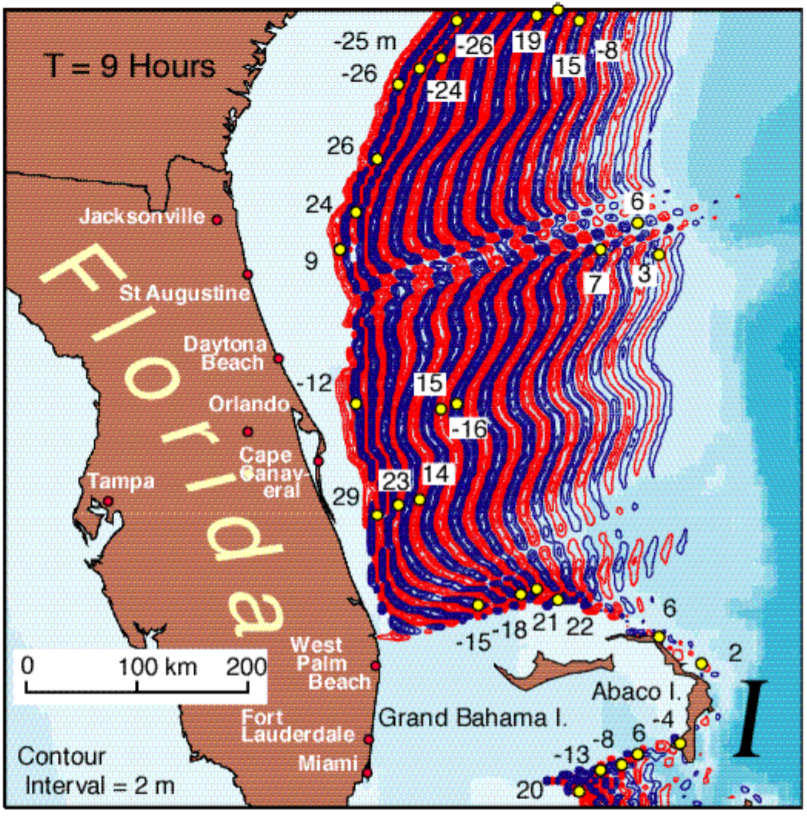The Cumbre Vieja volcano and the East Coast tsunami worst case scenario
The Cumbre Vieja erupted on September 19th, 2021. Could this generate a tsunami of significant magnitude?

Around 3pm local time (10 am ET) on September 19th, 2021, the Cumbre Vieja volcano began erupting, prompting about 5,000 evacuations and destroying over 100 homes. Located in La Palma Island, one of the Canary Islands, the volcano sits about 5,000 kilometers away from the East Coast. Yet, this eruption provides us with an opportunity to comment on an old debate: could such an eruption cause a mega tsunami ravaging coastlines as far as the U.S. East Coast? The answer is: Most probably not. Yet, the story around this scenario is a nice example of how science, the media and our inability to accurately consider low probability, high impact scenarios can mix together into catastrophist myths.
Regularly, this story has come up in the media around volcanic eruptions, due to its catastrophic potential. However, this extreme scenario is very unlikely to happen - even now, in the presence of an eruption of the Cumbre Vieja, and has been contradicted by later research. This article will first present the said scenario, before explaining why we are unlikely to see this happen.
The potential disaster
In 1949, the Cumbre Vieja erupted. During this eruption, a fault appeared on the volcano’s west side which could be interpreted as a sign of structural instability, potentially leading to a lateral collapse.
In a pioneering article in 2001, Steven N. Ward and Simon Day, scientists at the University of California, Santa Cruz and University College, London, published an interesting simulation of an extreme scenario in relation to the Cumbre Vieja volcano. Under a particularly intense eruption and an extremely unlikely combination of events, they hypothesized that the western flank of the volcano could fall into the sea, generating a tsunami of considerable magnitude. Enormous waves could then break on the U.S. East Coast, generating considerable damage and prompting numerous evacuations.
The following figure, reproduced from Ward and Day’s research, presents tsunami waves 9 hours after the simulated break:
On this figure, the yellow dots and their associated numbers represent the size of the simulated tsunami waves: according to the simulation, even after crossing the Atlantic Ocean, tsunami waves of 10 to 25m (up to 100 feet) could be felt along the U.S. East Coast, causing unprecedented damage.
Why it’s extremely unlikely to happen
The scenario of a mega-tsunami affecting the East Coast has attracted much interest - and criticism - since 2001.
Notably, it has been argued that geologists found no sign of such tsunamis in the past, while events involving lateral collapse have indeed been documented. This could be due to the fact that, for such a tsunami to happen, the western part of the volcano should collapse all at once (leading the authors to consider a 500 km3 volume of rock falling into the sea). Most importantly, it seems like lateral collapse events that occurred in the geological past of the Canary Islands all occurred in multiple stages, thereby generating much lower tsunami waves. Ward and Day’s research actually note that if the volume of rocks lowers from 500km3 to 250km3 (which is equivalent to say that the collapse occurs in two equal stages, and not all at once), wave size could be reduced by as much as 75%.
Additional stages would of course reduce wave size even further. In fact, Tehranirad and coauthors’s research in 2015 suggested that the credible worst case scenario for the Cumbre Vieja would imply 80km3 of rock to fall into the sea, thereby reducing wave size along the East Coast at about two meters only.
Conclusion
Early research mentioned the possibility to see a mega tsunami emerging from an eruption of the Cumbre Vieja, in case of its partial collapse. Later research found it to be extremely unlikely, if not impossible: tsunami leave geological footsteps, and no signs were found of such a tsunami in the past, suggesting that any potential collapse would occur in multiple stages: the worst case scenario would then imply moderate tsunami waves, reaching the East Coast with a 6 to 7 feet size.
In any case, rest assured: even if this remains the credible worst case scenario, the current eruption will not generate a tsunami of significant magnitude.
Papers cited:
Ward, S.N., and Day, S. Cumbre Vieja Volcano -- Potential collapse and tsunami at
La Palma, Canary Islands. Am. Geo. U. (2001). https://websites.pmc.ucsc.edu/~ward/papers/La_Palma_grl.pdf
Tehranirad, B., Harris, J.C., Grilli, A.R. et al. Far-Field Tsunami Impact in the North Atlantic Basin from Large Scale Flank Collapses of the Cumbre Vieja Volcano, La Palma. Pure Appl. Geophys. 172, 3589–3616 (2015). https://doi.org/10.1007/s00024-015-1135-5

